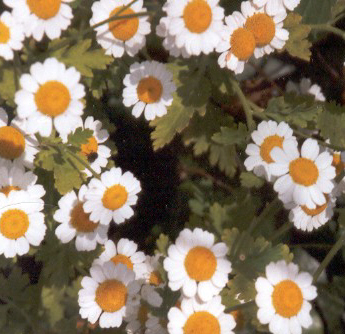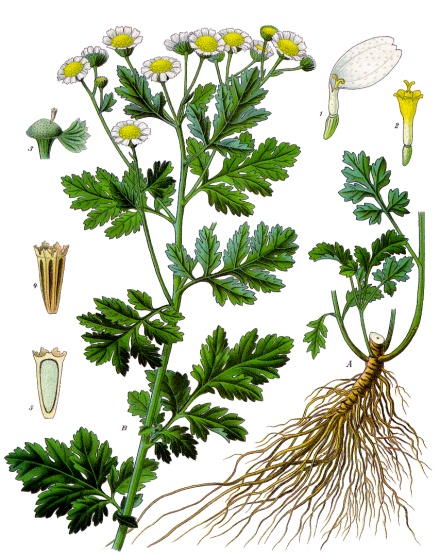Tanacetum parthenium (L)
Synonyms and Common names: Chrysanthemum parthenium (L), Leucanthemum parthenium, Pyrethrum parthenium, Tanacete parthenii herba or folium, Featherfew, Featherfoil, Midsummer daisy, Bachelor�s buttons, Altamisa, nosebleed, flirtwort
Order: Compositae

Description: Tanacetum parthenium is a perennial which grows up to 60cm tall, with a downy erect stem. The yellowish-green leaves are alternate, stalked, ovate and pinnately divided with an entire or crenate margin. The flowers, about 2cm in diameter, are arranged in corymbs of up to 30 heads, with white ray florets, yellow disc florets, and downy involucral bracts. The taste is bitter; the odour strongly aromatic
Parts used: Leaves
Collection: The leaves may be collected throughout spring and summer, but preferably before the flowering period.
Constituents: sesquiterpene lactones (including parthenolide and santamarine), volatile oil, sesquiterpenes (including camphor, farnesene and germacrene), tannins, monoterpenes
Actions: migraine prophylactic, anti-inflammatory, vasodilatory, antirheumatic, febrifuge, digestive bitter, anthelmintic, uterine stimulant
Indications: Migraine prophylaxis, arthritic conditions
 Therapeutics and Pharmacology: Although this herb has
long been used
in migraine prophylaxis, confirmed by clinical studies, the precise mechanism of
the action is not yet fully understood. It is thought that the prophylactic action is due to
serotonin (5-HT) inhibition, possibly via the
neutralisation of sulphydryl groups on specific enzymes that are fundamental to
platelet aggregation and secretion. Abnormal platelet behaviour with the release
of 5-HT has been implicated in migraine. Parthenolide also interferes with both
the
contractile and relaxant mechanisms in blood vessels. Many of the patients
involved in the clinical trials for migraine prophylaxis also reported that
feverfew helped their depression. It helps ease tinnitus and dizziness, and allays
nausea and vomiting.
Therapeutics and Pharmacology: Although this herb has
long been used
in migraine prophylaxis, confirmed by clinical studies, the precise mechanism of
the action is not yet fully understood. It is thought that the prophylactic action is due to
serotonin (5-HT) inhibition, possibly via the
neutralisation of sulphydryl groups on specific enzymes that are fundamental to
platelet aggregation and secretion. Abnormal platelet behaviour with the release
of 5-HT has been implicated in migraine. Parthenolide also interferes with both
the
contractile and relaxant mechanisms in blood vessels. Many of the patients
involved in the clinical trials for migraine prophylaxis also reported that
feverfew helped their depression. It helps ease tinnitus and dizziness, and allays
nausea and vomiting.
Tanacetum parthenium has long been reputed to help relieve arthritis, particularly in the painful active inflammatory stage. The sesquiterpene lactones, and particularly parthenolide, have been shown to inhibit human blood platelet aggregation and secretory activity in platelets and polymorphonuclear leucocytes (increased secretion is a feature of rheumatoid arthritis). However, a double-blind, placebo-controlled study over six weeks on 40 females with rheumatoid arthritis showed no beneficial effects.
T. Parthenium has been used in the treatment of dysmenorrhoea and sluggish menstrual flow, and an infusion may be taken to cleanse the uterus after childbirth. Antimicrobial properties against Gram-positive bacteria, yeasts and filamentous fungi in vitro have been documented for parthenolide; Gram-negative bacteria were not affected.
Caution: The fresh leaves can cause mouth ulceration or gastric disturbance so it is recommended that those taking the fresh leaf for migraine prophylaxis should take it with some bread. Contact allergy is rare. The herb is contraindicated in pregnancy due to its stimulating action on the uterus.
Preparation and Dosage: (daily dose)
Regulatory Status: GSL Schedule 1
Dried herb: 50-200mg, usually as capsules or tablets
Tincture: 1:5 in 25% alcohol, 5-20 drops
Additional Comments: Feverfew is a corruption of febrifuge. Culpeper wrote, �Venus commands this herb, and has commanded it to succour her sisters and be a general strengthener of their wombs�. Gerard recommended it as �very good for them that are giddie in the head, or which have the turning called Vertigo, that is, a swimming and turning in the head.� Feverfew is an effective insect repellent.
Bibliography
Bartram, T. 1995 Encyclopedia of Herbal Medicine, 1st edn.,Grace Publishers, Bournemouth.
Bradley, P.R. (ed.) 1992 British Herbal Compendium, Volume 1, BHMA, Bournemouth.
Bremness, L. 1994 Herbs, Dorling Kindersley Eyewitness Handbook, London.
Chevallier, A. 1996 The Encyclopedia of Medicinal Plants, Dorling Kindersley, London.
ESCOP Monograph, 1996 Tanaceti parthenii herba/folium, European Scientific Committee on Phytotherapy
Gerard, J. 1633 The Herball or Generall Historie of Plantes, Facsimile Edition (1975), Dover Publications, New York.
Grieve, M. 1931 A Modern Herbal, (ed. C.F. Leyel 1985), London.
Hoffmann, D. 1990 The New Holistic Herbal, Second Edition, Element, Shaftesbury.
Hyperhealth 1996 Natural Health and Nutrition Databank, v.96.1 CD-ROM, �In-Tele-Health, available from Healthworks, Leeds. ISBN 0-646-30942-0
Lust, J. 1990 The Herb Book, Bantam, London.
Mabey, R. (ed.) 1991 The Complete New Herbal, Penguin, London.
Mann, J. 1992 Murder, Magic and Medicine, Oxford University Press.
Mills, S.Y. 1993 The Essential Book of Herbal Medicine, Penguin, London (First published in 1991 as Out of the Earth, Arkana)
Newall, C.A., Anderson, L.A., & Phillipson, J.D. 1996 Herbal Medicines: A Guide for Health-care Professionals, The Pharmaceutical Press, London.
Ody, P. 1993 The Herb Society's Complete Medicinal Herbal, Dorling Kindersley, London.
Polunin, M. and Robbins, C. 1992 The Natural Pharmacy, Dorling Kindersley, London.
Wren, R.C. 1988 Potter's New Cyclopaedia of Botanical Drugs and Preparations, C.W.Daniel, Saffron Walden.










